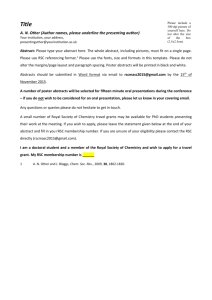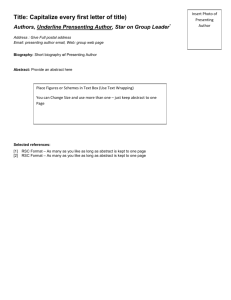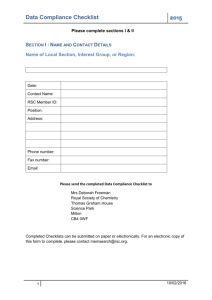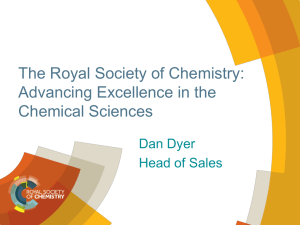MNRSC_Report_for_WSC_2012
advertisement
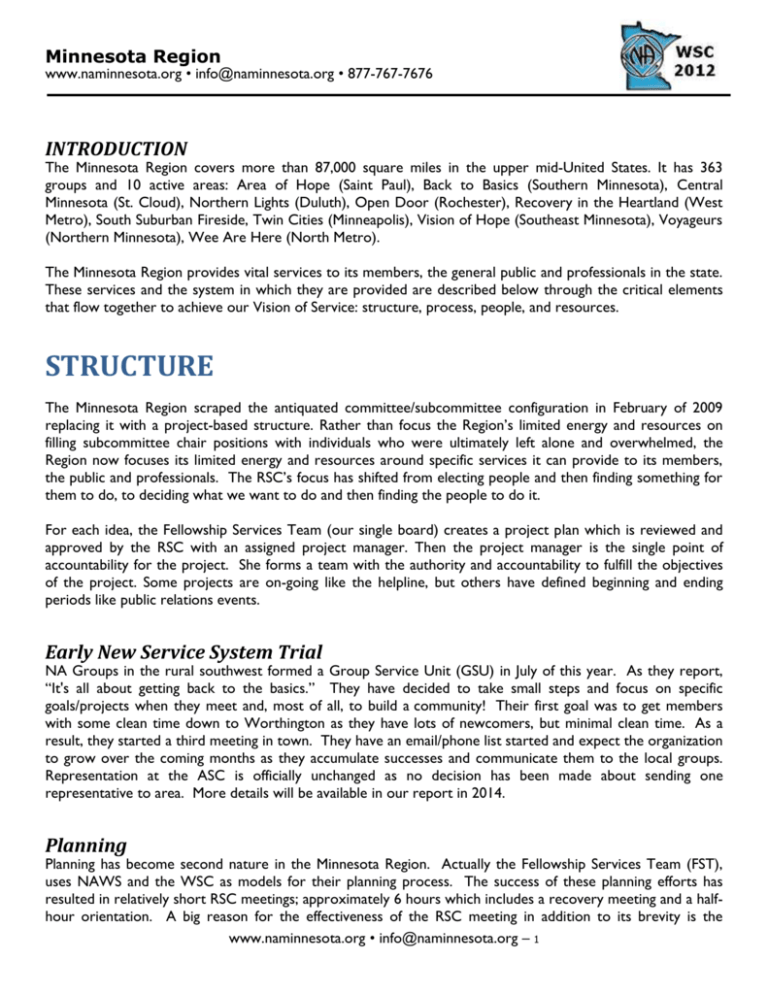
Minnesota Region www.naminnesota.org • info@naminnesota.org • 877-767-7676 INTRODUCTION The Minnesota Region covers more than 87,000 square miles in the upper mid-United States. It has 363 groups and 10 active areas: Area of Hope (Saint Paul), Back to Basics (Southern Minnesota), Central Minnesota (St. Cloud), Northern Lights (Duluth), Open Door (Rochester), Recovery in the Heartland (West Metro), South Suburban Fireside, Twin Cities (Minneapolis), Vision of Hope (Southeast Minnesota), Voyageurs (Northern Minnesota), Wee Are Here (North Metro). The Minnesota Region provides vital services to its members, the general public and professionals in the state. These services and the system in which they are provided are described below through the critical elements that flow together to achieve our Vision of Service: structure, process, people, and resources. STRUCTURE The Minnesota Region scraped the antiquated committee/subcommittee configuration in February of 2009 replacing it with a project-based structure. Rather than focus the Region’s limited energy and resources on filling subcommittee chair positions with individuals who were ultimately left alone and overwhelmed, the Region now focuses its limited energy and resources around specific services it can provide to its members, the public and professionals. The RSC’s focus has shifted from electing people and then finding something for them to do, to deciding what we want to do and then finding the people to do it. For each idea, the Fellowship Services Team (our single board) creates a project plan which is reviewed and approved by the RSC with an assigned project manager. Then the project manager is the single point of accountability for the project. She forms a team with the authority and accountability to fulfill the objectives of the project. Some projects are on-going like the helpline, but others have defined beginning and ending periods like public relations events. Early New Service System Trial NA Groups in the rural southwest formed a Group Service Unit (GSU) in July of this year. As they report, “It's all about getting back to the basics.” They have decided to take small steps and focus on specific goals/projects when they meet and, most of all, to build a community! Their first goal was to get members with some clean time down to Worthington as they have lots of newcomers, but minimal clean time. As a result, they started a third meeting in town. They have an email/phone list started and expect the organization to grow over the coming months as they accumulate successes and communicate them to the local groups. Representation at the ASC is officially unchanged as no decision has been made about sending one representative to area. More details will be available in our report in 2014. Planning Planning has become second nature in the Minnesota Region. Actually the Fellowship Services Team (FST), uses NAWS and the WSC as models for their planning process. The success of these planning efforts has resulted in relatively short RSC meetings; approximately 6 hours which includes a recovery meeting and a halfhour orientation. A big reason for the effectiveness of the RSC meeting in addition to its brevity is the www.naminnesota.org • info@naminnesota.org – 1 distribution of a detailed agenda at least a week before the meeting. The agenda includes not only the schedule, but also all motions, executive reports, project status reports, new project ideas, and project plans. Because RSC participants know exactly what to expect at the meeting, they can be prepared with questions and suggestions. The meeting runs more smoothly and efficiently and drama is kept to a minimum because there are no surprises. Planning the actual service delivery is all about project planning. The process looks like this: Project review, evaluation and renewal decision Project Idea discussed and approved Project Plan developed and approved Project Implementation Project team completes project plan Project Idea Purpose: What problem are we trying to solve? Objectives: What does the solution look like? Benefits: Who does this project help and how? Goals: How does this project fit with our long-term goals? Download the Project Idea Template Project Plan Project idea: from above Scope: What are we doing and NOT doing? Success Factors: How can we measure success? Plan: Step by step, what are we doing? Who is responsible for getting it done and when? Budget: How much is this going to cost? Download the Project Plan Template Budget Plan The annual budget contains a line item for each ongoing project like the helpline, the website, public relations events, etc. It also contains an estimate of funds required for the unknown projects that inevitably are proposed and implemented over the course of the year. The treasurer presents the first draft of the budget in August. RSC participants discuss and amend it in October and then review and approve it in December for the following year. Decision-making The Minnesota Region still allows everyone who attends the RSC meeting to vote on any issue facing the body. An individual doesn’t have to be elected to anything in order to vote at our RSC. As far as anyone knows, the Minnesota Region is the only service body in Narcotics Anonymous that operates this way. The MNRSC believes that to give ample opportunity to hear the voice of our loving higher power we need as many members as possible to play a part when decisions are made. This system permits our HP to speak through the roughly 20 – 30 members in attendance. Were the RSC to limit HPs voice to RCMs only, the math looks like this; Quorum requires 50% of active Areas, currently that would be 5 Areas. The minimum majority needed to pass a motion would then be 3 RCMs. The Minnesota Region is more confident that HP is heard through the collective wisdom in the room - that sound decisions are being made - when ten times that number are allowed to create our group conscience. In order to evaluate the validity of this belief the RSC voted twice on every motion for two years; once with everyone voting, and once with RCMs only voting. In two years there was no variance. The same decision www.naminnesota.org • info@naminnesota.org – 2 was made in every case. The RCMs control the agenda because an RCM is required to make or second a motion. The RSC maintains that the power isn’t in the voting, it is in determining what we’re voting on. GSR Assembly: Creating Our Common Welfare The annual GSR Assembly has come to be known as “Creating Our Common Welfare”. The meeting isn’t just for GSRs, but when the RSC changed the name to Regional Assembly or Annual Assembly, the GSRs stopped showing up. The idea is that by focusing on what comes first, “our common welfare”, the FST can increase the attendance of all NA members without losing the GSRs. Assembly Goals Garner member input and regional consensus on world-wide NA issues. Discuss issues facing the Minnesota region Strategic planning Assembly Process Presentations Small Group Discussion Large Group Discussion Communication Just like every other organization in the world, communication is the number one challenge facing the Minnesota region. In an effort to equalize the opportunity to serve for more members, the RSC uses conference calls, webinars and email Google groups to work on projects and keep in closer contact between RSC meetings. Because of this, the FST and project teams can actually get work done between RSC meetings and use the RSC meeting to simply report the progress of the work and solve problems that may have arisen. These are the communication methods utilized: MNRSC Google Group – Email discussion group of NA members in Minnesota FST Google Group – Email discussion group for Fellowship Services Team members Project Specific Google Group – Some project teams use email discussion groups to facilitate their work. Conference Call/Webinar – The FST meets at least once between each RSC meeting this way. Project teams also use this to do their work. Training sessions, Workshops and even the full RSC Meeting use this tool, www.anymeeting.com. Email via website – Regional and Area trusted servants can be contacted with the click of a mouse. Facebook – A social media account used to present NA news and local event reminders to friends of NAminnesota. (Currently 1,887 friends) Twitter - A social media account used to present NA news and local event reminders to followers of NAminnesota. (Currently 63 followers) Face to Face – Bimonthly RSC meetings. Meeting in person is always the best way. Google Documents – Online documents help provide accountability, transparency, and real-time collaboration. They are used for Volunteer sign-ups, Helpline activity reporting, Treasury bookkeeping, convention registration, inventory and project document sharing. Email distribution lists – subscribers (nearly 700 professionals and members) receive meeting lists emails once a month www.naminnesota.org • info@naminnesota.org – 3 Virtual RSC As a relatively large state, 550 miles across, it is difficult for member areas in the north to travel to the bimonthly RSC meetings. In addition, weather can be a problem. Last year the RSC meeting was canceled in the face of a massive snowstorm. In order to handle that inevitability again, the FST planned and held a virtual RSC meeting via conference call and webinar. The response was overwhelmingly positive. In the evaluation survey, nearly every metric was 4+ on a scale of 1-5. The RSC used www.anymeeting.com for the conference call/webinar. It is free and allows up to 200 participants to connect. The technology is quite solid. A full evaluation is available on our website at this link: Online MNRSC Meeting Evaluation. PEOPLE Members contributing their time to the fellowship make up the backbone of the services the Minnesota Region provides to its members, the general public, and to professionals. Signing up to serve is easy, just a few clicks away on www.naminnesota.org, or a member can simply send a text message. More than 220 members have signed up to participate in the Region’s service projects since the launch of the website in October of 2010. When NA members are offered specific, focused opportunities to carry the message, then they are willing to volunteer. Most members want to do service if they don’t have to go to committee meetings. New Project Highlight: Bridging the Gap The Bridging the Gap (BTG) project was approved in early summer of 2011 and was officially launched in October. BTG is a temporary contact program that offers new members a chance to make a connection to NA before walking into their first meeting. Volunteers, geo-coded in a confidential mapping database, are put in contact with a newcomer with the intent of meeting them at their first few meetings, introducing them to other members and potential sponsors, and sharing their own experience with recovery through NA. As of December 7th 182 NA members had signed up as temporary contacts, and there have been 26 requests by either the addicts themselves or professionals requesting a temporary contact on behalf of their clients. Requests for a contact can be made through the web, mail, text message, or by calling our helpline. One of the stumbling blocks early on has been professionals being confused about what we are offering. BTG is not a temporary sponsorship program, though forming that type of relationship is possible. The project team is currently looking into how the program can be presented better to help clear up confusion. Another stumbling block has been that many of the people being released from facilities have no email address and no phone number where they can be reached. The team is brainstorming solutions to these issues. www.naminnesota.org • info@naminnesota.org – 4 Helpline The Minnesota Region adopted an ongoing project to move its helpline from an answering service to an online Virtual PBX, www.phone.com. Since the move on July 19, 2010 we have received more than 6,200 calls (as of Dec 2011), a third of which, nearly 2,000, were people calling to talk to an addict. Within a minute, calls to addicts were answered 92% of the time with only 8% of the calls to volunteers going to voicemail. A dedicated volunteer returns the voicemail messages within 12 hours, typically within three. Members can volunteer to serve answering calls for as few as 3 hours per week from the comfort of their cell phone. Currently there are 64 volunteers serving on the state-wide helpline. Since the move, all Area helplines have consolidated their helpline numbers into the Region’s making it truly statewide. Not only has the Region’s helpline bill been cut by more than 50%, the Areas no longer have this expense on their books, saving even more. Altogether, the helpline consolidation continues to save the Region and its Areas more than $10,000 per year while at the same time providing service opportunities to addicts in far flung parts of Minnesota. Public Relations Projects The Minnesota Region continues to resource public relations projects such as attendance at the annual LGBT Pride festival attracting more than 350,000 participants, the Minnesota Association of Resources for Recovery and Chemical Health attended by more than 3,000 Chemical Dependency professionals, along with several other events both large and small. In response to projects brought to the Region by Areas, the Region is supporting bus shelter and bus bench advertisements. The RSC obtained the video public service announcements produced by the Michigan Region modified with the tag altered to include our helpline number (877) 767-7676 and www.naminnesota.org. The Back to Basics Area has placed this PSA on local television and radio stations. Recruitment Validating our belief that countless members will do service so long as they don’t have to attend committee meetings, more than 220 members have signed up to volunteer via a form on our website. RESOURCES Website: www.naminnesota.org We launched our new website in October of 2010 after nearly nine months of planning and development. The project plan called for six months of design and three months of development. It is designed to serve three user types: Professionals, the general public, NA members. We worked hard at making the layout natural and intuitive, drawing heavily on the principles found in Steve Krug’s book Don’t Make Me Think. The information that most users seek is within two clicks of the homepage: Find an NA Meeting Contact Us Print a Meeting List NA Events Frequently Asked Questions A section for each ASC Information about NA An online file cabinet for each board and committee www.naminnesota.org • info@naminnesota.org – 5 www.naminnesota.org is becoming a focus for Narcotics Anonymous across the state. The Digital Project Team (DPT) successfully uses social media to push news and event reminders out to subscribers, driving requests for more information to the region’s website. One ongoing Public Relations effort pulls probation professionals to our website by having this Narcotics Anonymous notice listed on the Minnesota Association of County Probation Officers website, http://www.macpo.net/juvenilecd.php#narca. After the RSC paid for the first year’s placement, the organization decided to run the notice for free thereafter. Before the launch of the new website some member Area Service Committees had been maintaining their own websites, but after seeing the value in a consistent professional presentation to the public and the added value afforded by the regional site, every one of them chose to abandon their old sites. Now each ASC has a web publisher who can manage the Area’s online file cabinet, and local events from the website front-end. The DPT hosts training via conference call/webinar with the web publishers every month to answer questions and make sure that they each have the minimal skills required to manage their section of the site. We use Google Analytics to evaluate the effectiveness of our site. This is a summary for the last 3 months. Basic Meeting List Toolbox The Region’s number one priority is to provide NA members, potential members, professionals and the general public with as many ways as possible to find Narcotics Anonymous meetings in Minnesota. It all starts with the Basic Meeting List Toolbox (BMLT). This powerful and easy to use platform provides a central repository for Regional meeting information. The BMLT, with its ever expanding list of Regions and Areas served, is free and technically supported by a generous NA member. It offers: Meeting schedule made accessible through helpline recordings Printed lists by State, multi-area (Metro), four geographic sections, and by common need Area lists Smartphone integration (app and mobile site) Meeting list subscribers (nearly 700) who receive meeting lists emails once a month By cloning the BMLT, the DPT solved a longstanding difficulty of knowing who in the Region is willing to be of service, and in which ways. Instead of entering Narcotics Anonymous meetings into the database, volunteer information is entered including specifics of willingness. In addition to providing a visual representation of the location of volunteers, this clone, the Trusted Servant List Tool (TSLT), allows the FST to provide monthly reports to the Areas detailing those willing to help with Public Relations, Hospital and Institutions, and Activities projects. Unlike the publicly available BMLT, the TSLT maintains the volunteer information in strictest confidence. www.naminnesota.org • info@naminnesota.org – 6 MNRSC Financials Income vs. Expenses Income Sources 40,000.00 30,000.00 Income 20,000.00 Expenses 10,000.00 0.00 16,000.00 14,000.00 12,000.00 10,000.00 8,000.00 6,000.00 4,000.00 2,000.00 0.00 2007 2008 2009 2010 2011 Area Donations MNNAC Groups/Other 2007 2008 2009 2010 2011 Expenses 22,500.00 20,000.00 17,500.00 15,000.00 2007 12,500.00 2008 2009 10,000.00 2010 2011 7,500.00 5,000.00 2,500.00 0.00 Administrative Contributions All-purpose PR Annual Assembly Regional Delegate Helpline www.naminnesota.org • info@naminnesota.org – 7 PR Projects Upper Midwest Service Office In recent years the long-term viability of our regional service office has come into question. The board has contracted services as sales have declined. The board is looking for ways to reverse these trends. Eliminated printing of regional and area meeting lists Eliminated shipping orders to individuals Reduced attendance at area events Reduced open office hours Sales down 40% Operating expenses flat Full evaluation available: UMSO Business Analysis ) www.naminnesota.org • info@naminnesota.org – 8
